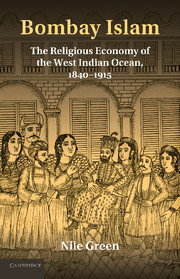Book contents
- Frontmatter
- Contents
- Illustrations
- Acknowledgements
- Maps
- Introduction
- 1 Missionaries and Reformists in the Market of Islams
- 2 Cosmopolitan Cults and the Economy of Miracles
- 3 The Enchantment of Industrial Communications
- 4 Exports for an Iranian Marketplace
- 5 The Making of a Neo-Ismā‘īlism
- 6 A Theology for the Mills and Dockyards
- 7 Bombay Islam in the Ocean's Southern City
- Conclusions
- Notes
- Bibliography
- Index
1 - Missionaries and Reformists in the Market of Islams
Published online by Cambridge University Press: 03 May 2011
- Frontmatter
- Contents
- Illustrations
- Acknowledgements
- Maps
- Introduction
- 1 Missionaries and Reformists in the Market of Islams
- 2 Cosmopolitan Cults and the Economy of Miracles
- 3 The Enchantment of Industrial Communications
- 4 Exports for an Iranian Marketplace
- 5 The Making of a Neo-Ismā‘īlism
- 6 A Theology for the Mills and Dockyards
- 7 Bombay Islam in the Ocean's Southern City
- Conclusions
- Notes
- Bibliography
- Index
Summary
CHRISTIANIZING CATALYSTS: THE IMPACT OF THE MISSIONARY SOCIETIES
Before turning towards the new Reformist firms that emerged among Bombay's Muslims in the mid-nineteenth century, we must first trace the activities of the ideological and organizational catalysts in the city's transformation into a competitive and pluralizing religious economy. These were the Christian missionary organizations whose great assault on the religions of Bombay formed the background to the emergence of the first Parsi, Hindu and Muslim Reformist groups in the city. While the Christian missions did not influence every group among the city's Muslims alike – Bombay's Iranian Muslims, for example, remained largely unaffected – their importance cannot be overlooked for the earlier part of the century, when the missions were the first substantial importers of unfamiliarly new religious productions to the city's growing populace. In triggering a set of defensive responses from Reformist organizations from across the spectrum of Indian religions, the missionaries played a key role in triggering the increasing pluralization and increasing production that would typify the religious economy of Bombay Islam. As an imperial port city, Bombay was intrinsically connected to developments in the imperial centre, even as its parallel existence as an Indian Ocean port ultimately held the potential to wash colonial influences beneath stronger tides of more regional cultural provenance. In religious terms, the most important example of these interconnections between Britain and its empire was the development of the missionary society.
- Type
- Chapter
- Information
- Bombay IslamThe Religious Economy of the West Indian Ocean, 1840–1915, pp. 24 - 48Publisher: Cambridge University PressPrint publication year: 2011
- 1
- Cited by



